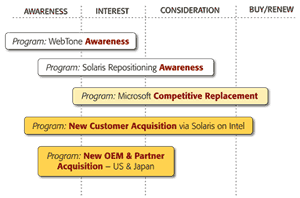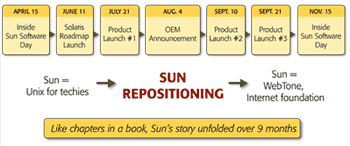
www.kickstartall.com
How Sun Re-invented the Marketing Campaign
by
Mike Gospe
This article is the first in a series taken from Mike Gospe's new book, Marketing Campaign Development: what marketing executives need to know about architecting global integrated marketing campaigns. The book can be ordered by clicking here.

| "In
order to improve your game, you must study the endgame
before everything else, for whereas the endings can
be studied and mastered by themselves, the middle
game and the opening must be studied in relation to the
endgame." Jose Raul Capablanca - one of the world's first chess grandmasters 1 |
Why is marketing campaign development important?
Good marketing can be equated to playing chess. Chess grandmasters are winners because they have been trained to think several moves ahead. And in this planning they are able to react to their opponents' moves with skill and finesse. They study the situation, making note of possible moves and then follow-on moves. They anticipate reactions, and then act accordingly. This very same approach is what Sun embraced in 1997 to reinvent its approach to marketing.
Sun Microsystems: a case study
In January 1997, I worked for Sun as one of its first marketing strategists and campaign managers. After careful investigation of the trends driving what would become the dotcom boom, we concluded that:
- 75% of all servers running the Internet were running the Sun Solaris operating system, and
- Nobody knew it.
Back in 1997, Sun was most commonly recognized as the provider of technical workstations. CEO Scott McNealy saw an opportunity to become more: for Sun to become the "Internet foundation." The first step in changing the rules was not to invent a new product, but to change the way Sun talked about itself and marketed its solutions. To achieve this positioning shift, Sun embarked on a two-phased marketing campaign that would first create awareness of Sun as the backbone of the Internet and then reposition Sun as a thought leader on business requirements for leveraging the Internet.
But this new marketing campaign wouldn't just magically appear. It would require a new customer-centric process for developing a marketing campaign. This was a significant change from the product-focused campaigns of the past. Sun's executive team took the following action:
- Formation of a new team: Instead of the usual product-focused marketing teams dictating marketing tactics, they anointed a virtual cross-functional, cross-geography marketing team that would be held accountable.
- Goals made visible: McNealy, with management support at every level, introduced this team and its goals to the rest of Sun.
- Introduction of the campaign manager: The vice president of global marketing introduced the role of the campaign manager, a new role within Sun, to guide the effort to unite/support a worldwide marketing team.
- Timeline defined: Competitive threats were many, and the window of opportunity was narrow. This team was given 90 days to develop the marketing strategy and a tactical plan for phase 1.
This new process gave birth to Sun's first truly integrated global marketing campaign. It was called the WebTone campaign. The word "WebTone" was defined to be "the 21st century Internet equivalent to today's dialtone." McNealy described this concept at every opportunity.
"In today's world, people pick up a phone, hear a dial tone, then communicate instantaneously around the world - in fact, you "boot" your telephone by just picking it up. Some companies are already taking advantage of a computing network without technologic, geographic or time barriers - a network over which partners, customers and employees can collaborate at any time, from anywhere, with anyone. To gain that competitive advantage, businesses are turning to the Internet, and Sun is providing the network foundation and delivering the continuous WebTone that makes it all possible." - Scott McNealy 2
The campaign development team understood that success would not be achieved overnight. Changing market perception would take 18 months to two years. It became immediately clear that their first challenge was to avoid the temptation to execute tactics for the sake of executing tactics. There were hundreds of marketing activities that could be performed. Everyone had his or her pet project. But throwing marketing efforts and dollars at everything would have been like tossing lit matches into the wind hoping one created a fire, burned brightly, and got noticed.
To ignite success that was worthy of attention with press and analysts as well as prospects and customers, the team knew they had to prioritize and understand their target audiences first. Only then would they be able to craft a story that would capture interest and speak to the relevance and opportunity that Internet computing provided. The first questions that needed to be answered included:
- Who are our primary target audiences and what are their business pain points?
- How can we help them gain competitive advantage using the Internet more than any competitive alternative?
- What is the most effective way of engaging with these audiences to tell them our story and nurture a dialog with them?
|
With the campaign strategy now identified and agreed upon, marketing creativity blossomed. Comprised within each of these five supporting programs was a small, but carefully scoped, series of marketing activities. Some of these were routine, others were not. Traditional marketing activities included: print and radio advertising that built on itself (like chapters in a book) over nine months; a new website and collateral materials; tightly-knitted sales messaging and training. But, creativity took a leap forward with the pursuit of new activities that had never been done before at Sun. Some of these included:
- "Inside Sun Software Days" - new analyst events designed to nurture one-on-one relationships with key analysts. Each of these events was designed to specifically highlight the commitment Sun was making to the WebTone strategy.
- New approach to direct marketing - instead of one "catch all" product-focused direct mail project, Sun executed an approach to reach three audiences separately but simultaneously: CIOs, line-of-business managers, and IT staff. Each target audience received a unique version of a common offer and action plan. Since these three audiences were involved in the sales decision, this direct marketing strategy actively created a one-on-one dialog with each, then encouraged the three audience members to put their pieces together to gain the ultimate benefit.
- Maintaining the drum beat - every speech that McNealy and other top execs made referenced the WebTone. For the next 18 months, every director, when interviewed about their business line, also referenced the WebTone strategy and highlighted how their products fit within it.
- Worldwide multi-faceted customer reference activities - Key customers were hand-selected to reinforce specific messaging. These customer stories were executed at precise times during the next year in order to keep a running stream of customer momentum.
|
Results
McNealy and his team recognized that the stakes were higher. A new approach to marketing was required. Only after the WebTone campaign objective, strategy, and campaign/launch plan (high-level) were approved did the team focus on the execution pieces. Had the marketing team jumped prematurely to execution before developing a thoughtful marketing strategy, these carefully-targeted, creative, impactful marketing programs and activities would have been missed.
The WebTone campaign was wildly successful on all accounts. This new approach to marketing campaign development was soon adopted throughout Sun, including its new Java business unit. Some of the results obtained included:
- 14% increase in annual revenue, driven in part by the WebTone campaign as recognized in the annual report, making Sun a $9.7 billion company by end of fiscal year 1998 3
- 90 days to execution! WebTone became the rallying cry.
- Process initiated January 2 (see figure 1.2)
- 30 days to get to Gate 1 (campaign strategy review with Sun's executive team)
- 15 days after that to get to Gate 2 (final approval of phase I tactics)
- Execution plans laid out in detail in time for the first "launch" which took place April 15
- 20-30% faster execution times (with much less frustration!) for all marketing activities because the strategy and messaging were approved before creative began (i.e. fewer rewrites were required).
- 3X more press coverage in the following six months than the previous period because the messaging was consistent, focused, and relevant.
- The 1st of many: The success of the WebTone campaign led to others, including the "We put the dot in dotcom" campaign.
- Higher team morale: The success of the WebTone campaign created a buzz internally. Marketing clearly made a difference, and people took notice.
Applying Sun's lessons to your marketing campaigns
Like we did at Sun, marketers must continually fight the temptation of blasting irrelevant messages to large groups of people and instead find a way to become more relevant to our target audiences. We can only hope to achieve success if we are thoughtful and pay attention to what we are saying, and when and how we are delivering the message. Success today requires marketers to apply the discipline of campaign development to better our chances of being able to cut through the clutter and be heard. This is how we will win marketing's chess game.
Marketing Campaign Development is about applying the practical lessons learned by Sun and best practices adopted by hi-tech companies such as Aspect, Genesys, Hewlett-Packard, Informatica, and Symantec, and scores of others. Every company is different. But, I guarantee you that 80% of the process steps, templates, and techniques included in this book can be applied to your business with great success today. It's your move.
Notes:
1. Chess-poster.com, www.chess-poster.com/english/notes_and_facts/chess_quotes.htm
2. Businesswire, "Sun reveals software strategy for establishing "WebTone" future of computing; Leading the charge to Java-ready information-efficient networks," April 15, 1997 http://findarticles.com/p/articles/mi_m0EIN/is_1997_April_15/ai_19314501
3. Sun Microsystems, Inc. 1998 Annual Report, pages 2, 8, "That's why so much of our efforts this year has been directed toward what we call the WebTone."
About the Author
Mike Gospe has helped companies like HP, Sun, Ariba, Informatica, Symantec, and a number of startups architect and execute winning marketing campaign processes. For more information on these and other tips and tricks, please contact Mike at 650.947.8974.

